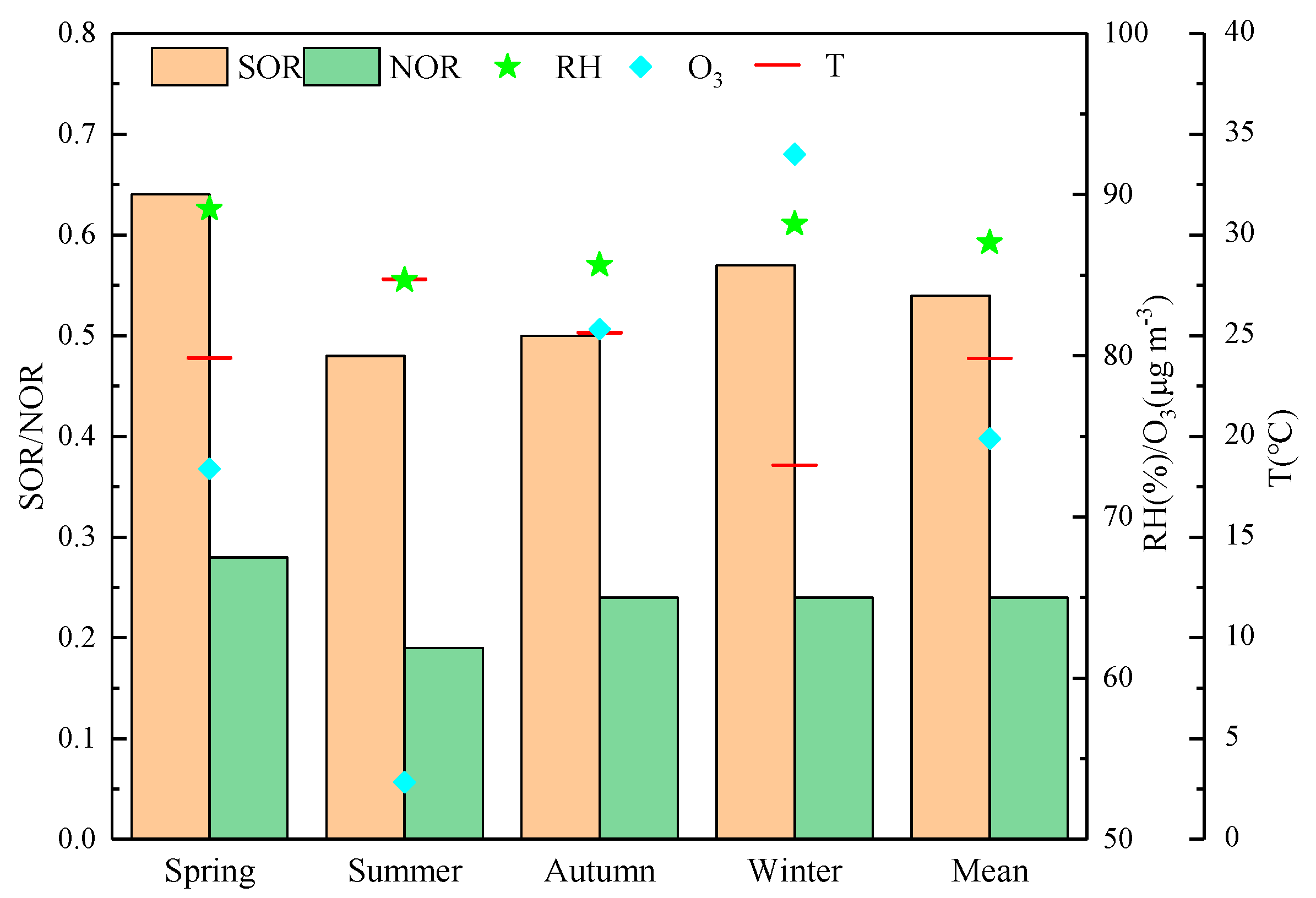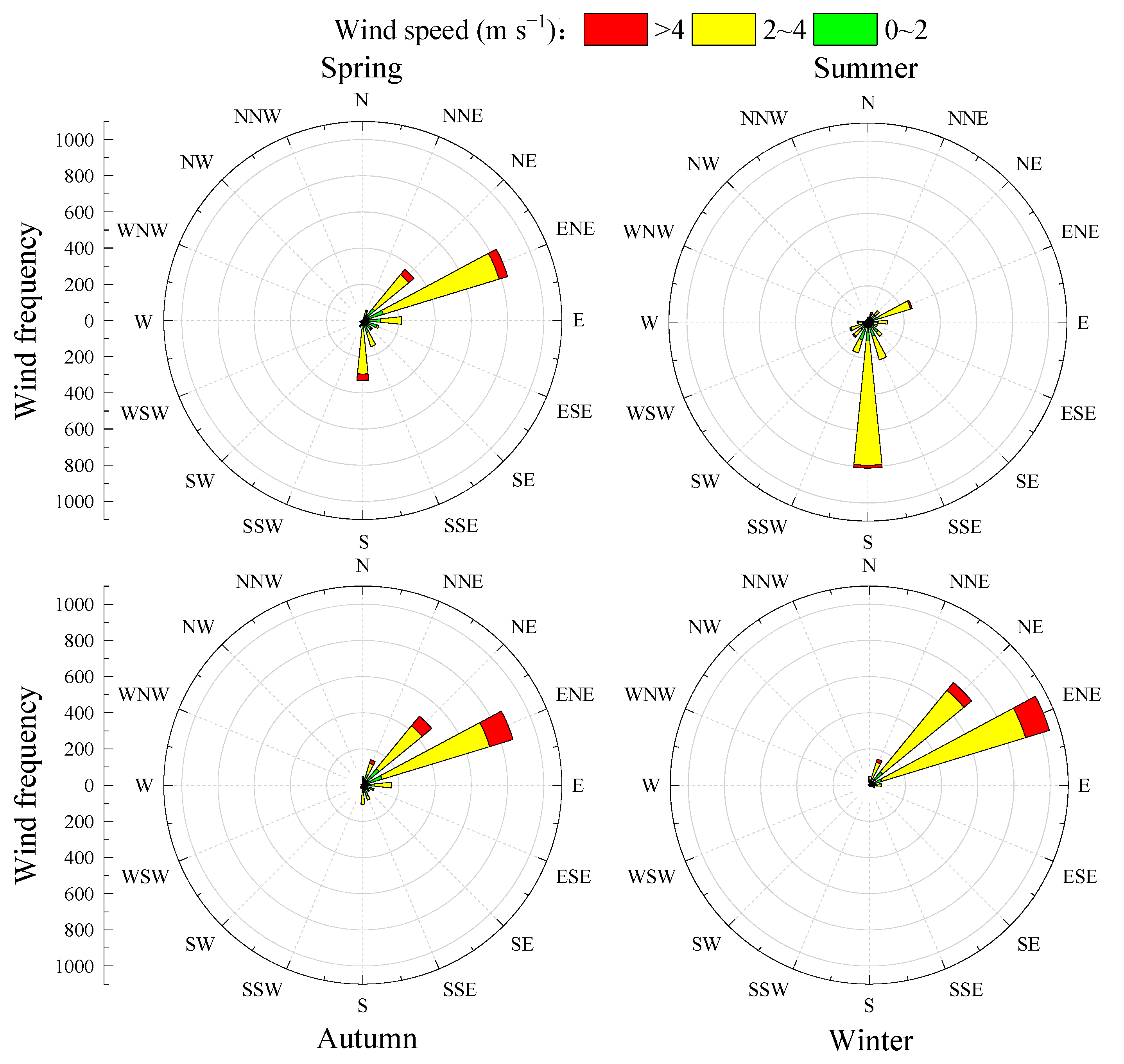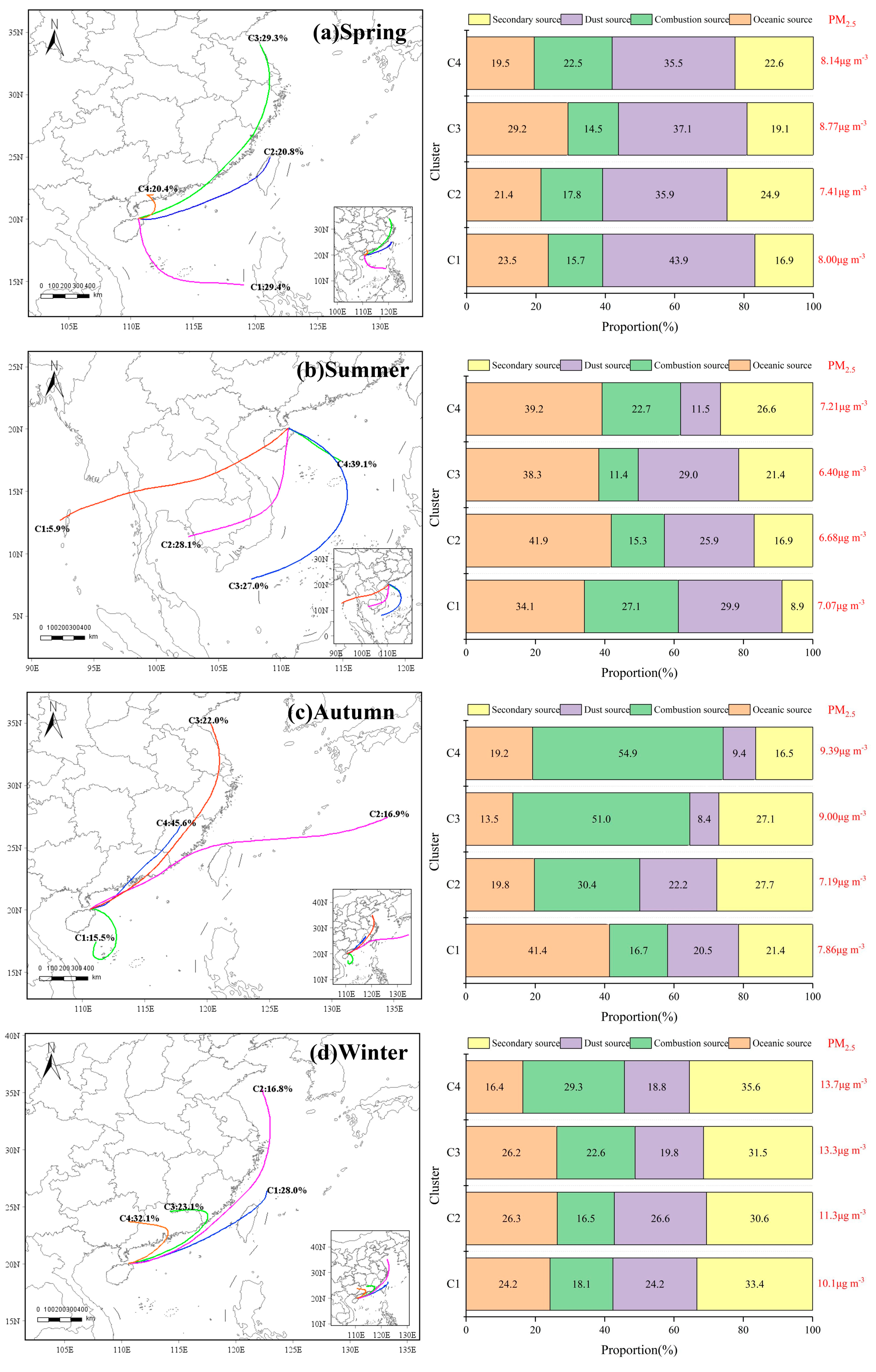Characterization and Source Analysis of Water-Soluble Ions in PM2.5 at Hainan: Temporal Variation and Long-Range Transport
Highlights
- We found that among all water-soluble ions affecting Hainan, secondary ions (SO42-, NO3-, NH4+) were dominant, accounting for 84.0%, followed by sea salt particles.
- We confirmed that secondary, combustion, dust and oceanic sources are the main sources of PM2.5 at the monitoring site in Hainan, a tropical area.
- This study demonstrated that the potential sources and transport pathways of water-soluble ions exhibit distinct seasonal characteristics, with the air mass trajectories in winter being more significantly influenced by anthropogenic factors.
- The results of this study suggest that air masses originating from the Pearl River Delta and the coastal regions of Fujian make a substantial contribution to the PM2.5 concentrations in Hainan.
Abstract
1. Introduction
2. Materials and Methods
2.1. Monitoring Locations and Monitoring Time
2.2. Monitoring Instruments
2.3. Methods of Analysis
2.3.1. Positive Definite Matrix Factorization (PMF)
2.3.2. HYSPLIT Model
3. Results and Discussion
3.1. Pollution Characteristics of PM2.5 and Water-Soluble Ions
3.1.1. Characteristics of Seasonal Changes
3.1.2. Characterization of Daily Changes
3.1.3. Compositional Characteristics at Different PM2.5 Concentrations
3.2. Secondary Conversion Characteristics
3.3. Correlation Analysis of PM2.5 with Water-Soluble Ions and Meteorological Factors
3.4. Source Analysis
3.5. Backward Trajectory Analysis
4. Conclusions
Author Contributions
Funding
Institutional Review Board Statement
Informed Consent Statement
Data Availability Statement
Conflicts of Interest
Abbreviations
| PMF | Positive Matrix Factorization |
| WSI | Water-soluble Ions |
| SNA | Sulfate (SO42−), Nitrate (NO3−), and Ammonium (NH4+) |
| EPA | Environmental Protection Agency |
| TWSI | Total Water-soluble Ions |
| DMS | Dimethylsulfide |
| SOR | Sulfur Oxidation Rate |
| NOR | Nitrogen Oxidation Rate |
References
- Jiang, Q.; Zhang, B.H.; Zhao, Y.L.; Wang, F.; Sun, Y.L. Growth mechanism of PM2.5 and its chemical components in Beijing’s urban area from 2013 to 2020. Chin. J. Atmos. Sci. 2023, 47, 373–386. Available online: http://www.iapjournals.ac.cn/dqkx/article/doi/10.3878/j.issn.1006-9895.2110.21142 (accessed on 18 September 2025). (In Chinese).
- Wang, X.Q.; Wei, W.; Cheng, S.Y.; Yao, S.; Zhang, H.Y.; Zhang, C. Characteristics of PM2.5 and SNA components and meteorological factors impact on air pollution through 2013–2017 in Beijing, China. Atmos. Pollut. Res. 2019, 10, 1976–1984. [Google Scholar] [CrossRef]
- Qi, L.; Zhang, Y.; Ma, Y.; Chen, M.; Ge, X.; Ma, Y.; Zheng, J.; Wang, Z.; Li, S. Source identification of trace elements in the atmosphere during the second Asian Youth Games in Nanjing, China: Influence of control measures on air quality. Atmos. Pollut. Res. 2016, 7, 547–556. [Google Scholar] [CrossRef]
- Kong, S.F.; Li, L.; Li, X.X.; Yin, Y.; Chen, K.; Liu, D.T.; Yuan, L.; Zhang, Y.J.; Shan, Y.P.; Ji, Y.Q. The impacts of firework burning at the Chinese Spring Festival on air quality: Insights of tracers, source evolution and aging processes. Atmos. Chem. Phys. 2015, 14, 2167–2184. [Google Scholar] [CrossRef]
- Kumari, P.; Toshniwal, D. Impact of lockdown measures during COVID-19 on air quality-A case study of India. Int. J. Environ. Health Res. 2022, 32, 503–510. [Google Scholar] [CrossRef] [PubMed]
- Sulaymon, I.D.; Zhang, Y.; Hopke, P.K.; Zhang, Y.; Hua, J.; Mei, X. COVID-19 pandemic in Wuhan: Ambient air quality and the relationships between criteria air pollutants and meteorological variables before, during, and after lockdown. Atmos. Res. 2021, 250, 105362. [Google Scholar] [CrossRef] [PubMed]
- Zheng, H.; Kong, S.F.; Yan, Q.; Wu, F.Q.; Cheng, Y.; Zheng, S.R.; Wu, J.; Yang, G.; Zheng, M.; Tang, L.; et al. The impacts of pollution control measures on PM2.5 reduction: Insights of chemical composition, source variation and health risk. Atmos. Environ. 2018, 197, 103–117. [Google Scholar] [CrossRef]
- Yuan, C.S.; Hung, C.M.; Hung, K.N.; Yang, Z.M.; Cheng, P.H.; Soong, K.Y. Route-based chemical significance and source origin of marine PM2.5 at three remote islands in East Asia: Spatiotemporal variation and long-range transport. Atmos. Pollut. Res. 2023, 14, 101762. [Google Scholar] [CrossRef]
- Li, T.C.; Yuan, C.S.; Huang, H.C.; Lee, C.L.; Wu, S.P.; Tong, C. Inter-comparison of seasonal variation, chemical characteristics, and source identification of atmospheric fine particles on both sides of the Taiwan Strait. Sci. Rep. 2016, 6, 22956. [Google Scholar] [CrossRef]
- Yue, D.; Zhong, L.; Zhang, T.; Shen, J.; Zhou, Y.; Zeng, L.; Dong, H.; Ye, S. Pollution properties of water-soluble secondary inorganic ions in atmospheric pm_(2.5) in the pearl river delta region. Aerosol Air Qual. Res. 2015, 15, 1737–1747. [Google Scholar] [CrossRef]
- Meng, C.C.; Wang, L.T.; Zhang, F.F.; Wei, Z.; Ma, S.M.; Ma, X.; Yang, J. Characteristics of concentrations and water-soluble inorganic ions in PM2.5 in Handan City, Hebei province, China. Atmos. Res. 2016, 171, 133–146. [Google Scholar] [CrossRef]
- Hong, X.P.; Yang, K.; Liang, H.D.; Shi, Y.Y. Characteristics of water-soluble inorganic ions in PM2.5 in typical urban areas of Beijing, China. ACS Omega, 2022; 7, 35575–35585. [Google Scholar] [CrossRef]
- Wang, B.; Tang, Z.; Cai, N.; Niu, H. The characteristics and sources apportionment of water-soluble ions of PM2.5 in suburb Tangshan, China. Urban Clim. 2021, 35, 100742. [Google Scholar] [CrossRef]
- Zhao, M.; Qiao, T.; Huang, Z.; Zhu, M.; Xu, W.; Xiu, G.; Tao, J.; Lee, S. Comparison of ionic and carbonaceous compositions of PM2.5 in 2009 and 2012 in Shanghai, China. Sci. Total Environ. 2015, 536, 695–703. [Google Scholar] [CrossRef]
- Wu, L.; Wang, Y.; Li, L.; Zhang, G. Acidity and inorganic ion formation in PM2.5 based on continuous online observations in a South China megacity. Atmos. Pollut. Res. 2020, 11, 1339–1350. [Google Scholar] [CrossRef]
- Cao, X.C.; Xing, Q.; Hu, S.H.; Xu, W.S.; Xie, R.F.; Xian, A.D.; Xie, W.; Yang, Z.; Wu, X. Characterization, reactivity, source apportionment, and potential source areas of ambient volatile organic compounds in a typical tropical city. J. Environ. Sci. 2023, 123, 417–429. [Google Scholar] [CrossRef]
- Xu, W.S.; Xing, Q.; Pan, L.B.; Wang, Z.S.; Cao, X.C.; Yan, W.J.; Xie, W.; Meng, X.; Wu, X. Characterization, source apportionment, and risk assessment of ambient volatile organic compounds in urban and background regions of Hainan Island, China. Atmos. Environ. 2024, 316, 120167. [Google Scholar] [CrossRef]
- Xu, X.H.; Xu, W.S.; Meng, X.X.; Xing, B.C.; Zeng, Z.H.; Sheng, H.; Yan, W. Analysis of impacts of biomass burning in southeast Asia on air quality in Hainan island. Environ. Monit. China 2025, 41, 42–52. (In Chinese) [Google Scholar]
- Yu, Y.Y.; Zhou, H.Y.; Zhao, Z.Z.; Chang, Y.H.; Wu, D.; Li, Z.Q.; Wang, F.; Fang, M.; Zhou, X. Spatiotemporal distribution, meteorological influence, and potential sources of air pollution over Hainan island, China. Atmosphere 2024, 15, 1336. [Google Scholar] [CrossRef]
- Zong, Z.; Wang, X.P.; Tian, C.G.; Chen, Y.J.; Qu, L.; Ji, L.; Zhi, G.; Li, J.; Zhang, G. Source apportionment of PM2.5 at a regional background site in North China using PMF linked with radiocarbon analysis: Insight into the contribution of biomass burning. Atmos. Chem. Phys. 2016, 16, 11249–11265. [Google Scholar] [CrossRef]
- Paatero, P.; Tapper, U. Analysis of different modes of factor analysis as least squares fit problems. Chemom. Intell. Lab. Syst. 1993, 18, 183–194. [Google Scholar] [CrossRef]
- Wang, Y.Q.; Zhang, X.Y.; Draxler, R.R. TrajStat: GIS-based software that uses various trajectory statistical analysis methods to identify potential sources from long-term air pollution measurement data. Environ. Model. Softw. 2009, 24, 938–939. [Google Scholar] [CrossRef]
- Zhan, Y.Z.H.; Xie, M.; Zhao, W.; Wang, T.J.; Gao, D.; Chen, P.L.; Tian, J.; Zhu, K.; Li, S.; Zhuang, B.; et al. Quantifying the seasonal variations in and regional transport of PM2.5 in the Yangtze River Delta region. Atmos. Chem. Phys. 2023, 23, 9837–9852. [Google Scholar] [CrossRef]
- Gao, H.; Wei, J.; Wang, Y. Seasonal variation and source analysis of water-soluble inorganic salts in PM2.5 in the southern suburbs of Beijing. Environ. Sci. 2018, 39, 1987–1993. (In Chinese) [Google Scholar]
- Wang, X.; An, J.L.; Su, X.Q.; Liang, J.S.; Liu, J.D. Characteristics and optical properties of water-soluble ion pollution in the northern suburbs of Nanjing. China Environ. Sci. 2020, 40, 506–512. (In Chinese) [Google Scholar]
- Hu, S.H.; Wu, X.C.; Xu, W.S.; Xie, R.F.; Xian, A.D.; Yang, Z.H. Characteristics and source analysis of water-soluble ions in PM2.5 in Sanya. Acta Sci. Circumst. 2021, 41, 2540–2549. (In Chinese) [Google Scholar]
- Xie, Y.; Lu, H.; Yi, A.; Zhang, Z.; Zheng, N.; Fang, X.; Xiao, H. Characterization and source analysis of water-soluble ions in PM2.5 at a background site in Central China. Atmos. Res. 2019, 239, 104881. [Google Scholar] [CrossRef]
- Shi, G.; Xu, J.; Peng, X.; Xiao, Z.; Chen, K.; Tian, Y.; Guan, X.; Feng, Y.; Yu, H.; Nenes, A.; et al. pH of Aerosols in a Polluted Atmosphere: Source Contributions to Highly Acidic Aerosol. Environ. Sci. Technol. 2017, 51, 4289–4296. [Google Scholar] [CrossRef]
- Liu, J.; Wu, D.; Fan, S.; Mao, X.; Chen, H. A one-year, on-line, multi-site observational study on water-soluble inorganic ions in PM2.5 over the Pearl River Delta region, China. Sci. Total Environ. 2017, 601–602, 1720–1732. [Google Scholar] [CrossRef] [PubMed]
- Sun, Y.L.; Wang, Z.F.; Fu, P.Q.; Yang, T.; Jiang, Q.; Dong, H.B.; Li, J.; Jia, J.J. Aerosol composition, sources and processes during wintertime in Beijing, China. Atmos. Chem. Phys. 2013, 13, 4577–4592. [Google Scholar] [CrossRef]
- Li, J.-M.; Zhao, S.-M.; Xiao, S.-H.; Li, X.; Wu, S.-P.; Zhang, J.; Schwab, J.J. Source apportionment of water-soluble oxidative potential of PM2.5 in a port city of Xiamen, Southeast China. Atmos. Environ. 2023, 314, 120122. [Google Scholar] [CrossRef]
- Fang, Y.; Cao, F.; Fan, M.Y.; Zhang, Y.L. Chemical characteristics and source apportionment of water-soluble ions in atmosphere aerosols over the East China sea island during winter and summer. Environ. Sci. 2020, 41, 1025–1035. (In Chinese) [Google Scholar]
- Zhang, C.; Wang, L.L.; Qi, M.; Ma, X.; Zhao, L.; Ji, S.; Wang, Y.; Lu, X.; Wang, Q.; Xu, R.; et al. Evolution of key chemical components in PM2.5 and potential formation mechanisms of serious haze events in Handan, China. Aerosol Air Qual. Res. 2018, 18, 1545–1557. [Google Scholar] [CrossRef]
- Cao, Y.; Liu, J.; Ma, Q.; Zhang, C.; Zhang, P.; Chen, T.; Wang, Y.; Chu, B.; Zhang, X.; Francisco, J.S.; et al. Photoactivation of chlorine and its catalytic role in the formation of sulfate aerosols. J. Am. Chem. Soc. 2024, 146, 1467–1475. [Google Scholar] [CrossRef]
- Cheng, C.; Shi, M.; Liu, W.; Mao, Y.; Hu, J.; Tian, Q.; Chen, Z.; Hu, T.; Xing, X.; Qi, S. Characteristics and source apportionment of water-soluble inorganic ions in PM2.5 during a wintertime haze event in Huanggang, central China. Atmos. Pollut. Res. 2021, 12, 111–123. [Google Scholar] [CrossRef]
- Galindo, N.; Nicolás, J.; Yubero, E.; Caballero, S.; Pastor, C.; Crespo, J. Factors affecting levels of aerosol sulfate and nitrate on the Western Mediterranean coast. Atmos. Res. 2008, 88, 305–313. [Google Scholar] [CrossRef]
- Huang, D.; Xu, J.; Zhang, S. Valuing the health risks of particulate air pollution in the Pearl River Delta, China. Environ. Sci. Policy 2012, 15, 38–47. [Google Scholar] [CrossRef]
- Xue, G.Q.; Zhu, B.; Wang, H.L. Size distributions and source apportionment of soluble ions in aerosol in Nanjing. Environ. Sci. 2014, 35, 1633–1643. Available online: https://www.hjkx.ac.cn/ch/reader/view_abstract.aspx?file_no=20140502&flag=1 (accessed on 18 September 2025). (In Chinese).
- Zhang, F.; Cheng, H.-R.; Wang, Z.-W.; Lv, X.-P.; Zhu, Z.-M.; Zhang, G.; Wang, X.-M. Fine particles (PM2.5) at a CAWNET background site in Central China: Chemical compositions, seasonal variations and regional pollution events. Atmos. Environ. 2014, 86, 193–202. [Google Scholar] [CrossRef]
- Li, H.; Wang, Q.; Yang, M.; Li, F.; Wang, J.; Sun, Y.; Wang, C.; Wu, H.; Qian, X. Chemical characterization and source apportionment of PM2.5 aerosols in a megacity of Southeast China. Atmos. Res. 2016, 181, 288–299. [Google Scholar] [CrossRef]
- Pant, P.; Harrison, R.M. Critical review of receptor modelling for particulate matter: A case study of India. Atmos. Environ. 2012, 49, 1–12. [Google Scholar] [CrossRef]
- Shu, L.; Xie, M.; Gao, D.; Wang, T.; Peng, L. Regional severe particle pollution and its association with synoptic weather patterns in the Yangtze River Delta region, China. Atmos. Chem. Phys. 2017, 21, 12871–12891. [Google Scholar] [CrossRef]
- Sheng, H.; Yan, W.J.; Meng, X.X.; Xu, X.H.; Mai, X.Q.; Xu, W.S. Analysis of the impact of a typical dust storm event on air quality in tropical regions of China. Acta Sci. Circumst. 2024, 44, 310–319. (In Chinese) [Google Scholar]
- Xu, H.; Cao, J.; Chow, J.C.; Huang, R.-J.; Shen, Z.; Chen, L.A.; Ho, K.F.; Watson, J.G. Inter-annual variability of wintertime PM2.5 chemical composition in Xi’an, China: Evidences of changing source emissions. Sci. Total Environ. 2016, 545, 546–555. [Google Scholar] [CrossRef] [PubMed]









| Species | Category | R2 | Intercept | Intercept SE | Slope | Slope SE | SE |
|---|---|---|---|---|---|---|---|
| Cl− | Strong | 0.986 | 0.017 | 0.004 | 0.954 | 0.006 | 0.038 |
| NO3− | Strong | 0.438 | 0.636 | 0.038 | 0.295 | 0.019 | 0.440 |
| SO42− | Strong | 0.502 | 0.675 | 0.119 | 0.609 | 0.034 | 1.047 |
| Na+ | Strong | 0.994 | −0.005 | 0.002 | 1.019 | 0.005 | 0.017 |
| K+ | Strong | 0.990 | 0.012 | 0.001 | 0.933 | 0.005 | 0.015 |
| NH4+ | Strong | 0.610 | 0.322 | 0.045 | 0.569 | 0.026 | 0.455 |
| Mg2+ | Strong | 0.851 | 0.011 | 0.001 | 0.810 | 0.019 | 0.014 |
| Ca2+ | Strong | 0.994 | 0.000 | 0.001 | 0.997 | 0.004 | 0.006 |
| Season | Spring | Summer | Autumn | Winter | Mean |
|---|---|---|---|---|---|
| SO42− | 3.3 ± 1.7 | 1.7 ± 0.8 | 2.9 ± 1.7 | 3.9 ± 1.9 | 2.9 ± 1.8 |
| NO3− | 1.4 ± 0.7 | 0.79 ± 0.2 | 1.1 ± 0.6 | 2.8 ± 2.2 | 1.5 ± 1.4 |
| NH4+ | 1.4 ± 0.7 | 0.73 ± 0.34 | 1.2 ± 0.7 | 2.2 ± 0.75 | 1.4 ± 1.1 |
| Cl− | 0.56 ± 0.31 | 0.32 ± 0.16 | 0.44 ± 0.31 | 0.70 ± 0.41 | 0.50 ± 0.34 |
| Na+ | 0.32 ± 0.21 | 0.19 ± 0.10 | 0.29 ± 0.22 | 0.31 ± 0.23 | 0.28 ± 0.20 |
| K+ | 0.19 ± 0.21 | 0.11 ± 0.07 | 0.15 ± 0.15 | 0.29 ± 0.14 | 0.18 ± 0.16 |
| Ca2+ | 0.15 ± 0.086 | 0.10 ± 0.056 | 0.052 ± 0.047 | 0.11 ± 0.081 | 0.10 ± 0.077 |
| Mg2+ | 0.065 ± 0.043 | 0.032 ± 0.028 | 0.041 ± 0.039 | 0.058 ± 0.049 | 0.049 ± 0.042 |
| SNA | 6.1 ± 3.2 | 3.2 ± 1.3 | 5.3 ± 3.3 | 9.0 ± 5.5 | 5.9 ± 4.0 |
| TWSI | 7.4 ± 3.7 | 3.9 ± 1.3 | 6.3 ± 3.3 | 10.4 ± 5.5 | 7.0 ± 4.4 |
| PM2.5 | 9.0 ± 2.9 | 6.9 ± 1.1 | 9.2 ± 4.1 | 13.0 ± 5.8 | 9.5 ± 4.4 |
Disclaimer/Publisher’s Note: The statements, opinions and data contained in all publications are solely those of the individual author(s) and contributor(s) and not of MDPI and/or the editor(s). MDPI and/or the editor(s) disclaim responsibility for any injury to people or property resulting from any ideas, methods, instructions or products referred to in the content. |
© 2025 by the authors. Licensee MDPI, Basel, Switzerland. This article is an open access article distributed under the terms and conditions of the Creative Commons Attribution (CC BY) license (https://creativecommons.org/licenses/by/4.0/).
Share and Cite
Xu, X.; Xu, W.; Meng, X.; Cao, X.; Chu, B.; Du, C.; Xie, R.; Zeng, Z.; Sheng, H.; Lin, Y.; et al. Characterization and Source Analysis of Water-Soluble Ions in PM2.5 at Hainan: Temporal Variation and Long-Range Transport. Toxics 2025, 13, 804. https://doi.org/10.3390/toxics13090804
Xu X, Xu W, Meng X, Cao X, Chu B, Du C, Xie R, Zeng Z, Sheng H, Lin Y, et al. Characterization and Source Analysis of Water-Soluble Ions in PM2.5 at Hainan: Temporal Variation and Long-Range Transport. Toxics. 2025; 13(9):804. https://doi.org/10.3390/toxics13090804
Chicago/Turabian StyleXu, Xinghong, Wenshuai Xu, Xinxin Meng, Xiaocong Cao, Biwu Chu, Chuandong Du, Rongfu Xie, Zhaohe Zeng, Hui Sheng, Youjing Lin, and et al. 2025. "Characterization and Source Analysis of Water-Soluble Ions in PM2.5 at Hainan: Temporal Variation and Long-Range Transport" Toxics 13, no. 9: 804. https://doi.org/10.3390/toxics13090804
APA StyleXu, X., Xu, W., Meng, X., Cao, X., Chu, B., Du, C., Xie, R., Zeng, Z., Sheng, H., Lin, Y., Yan, W., & He, H. (2025). Characterization and Source Analysis of Water-Soluble Ions in PM2.5 at Hainan: Temporal Variation and Long-Range Transport. Toxics, 13(9), 804. https://doi.org/10.3390/toxics13090804







